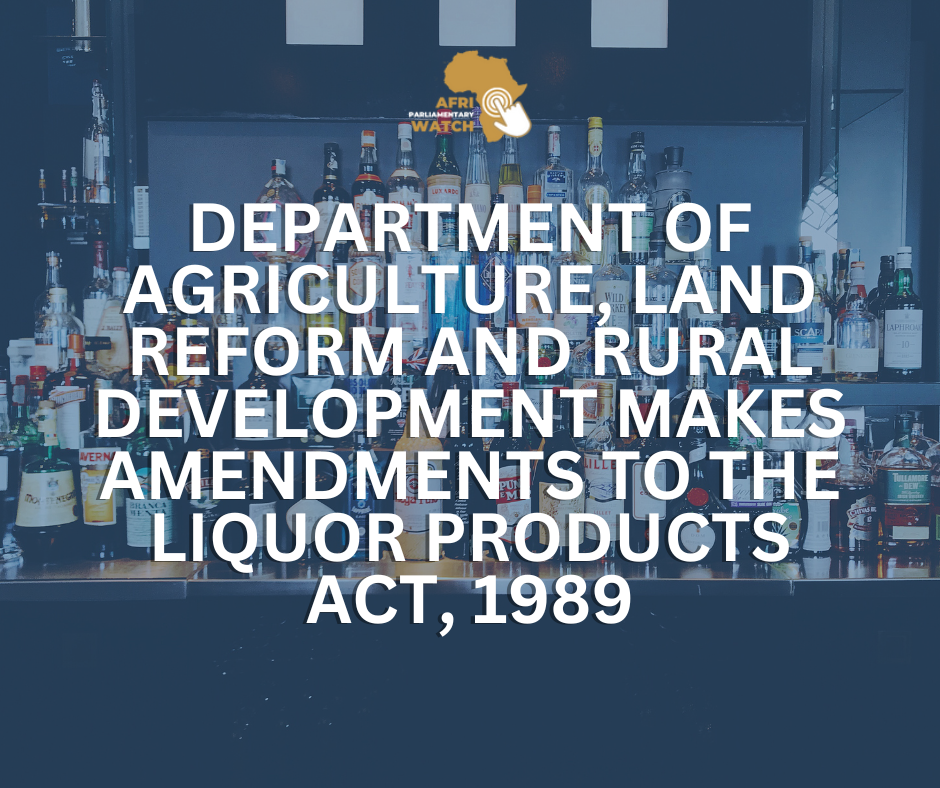DEPARTMENT OF AGRICULTURE, LAND REFORM AND RURAL DEVELOPMENT MAKES AMENDMENTS TO THE LIQUOR PRODUCTS ACT, 1989
To see the full document, click here
The recent amendments to the Liquor Products Act regulations signify a comprehensive update aimed at enhancing the classification and quality control of various alcoholic beverages. New definitions have been introduced for diverse categories, including agave, flavoured spirits, and traditional African beer, refining the spectrum of products covered by the regulations. Specific requirements regarding sourcing, production processes, and maximum allowable sugar content have been established for various classes of liquor, ensuring that each category maintains its unique characteristics. Notably, the revisions dictate tighter controls on alcohol content and volatile acid levels, strengthening the framework under which these drinks are regulated and marketed.
In addition to defining new classes of beverages and regulating their production standards, the updates clarify existing regulations regarding labeling and consumer information. This includes stricter guidelines on residual sugar content and alcohol levels, ensuring that manufacturers adhere to high-quality standards. The comprehensive nature of these amendments reveals a commitment to ensuring that consumer safety and product integrity are prioritized. By tightening the regulatory environment for alcoholic beverages, the Department of Agriculture, Land Reform and Rural Development aims not only to protect consumers but also to foster a more transparent and responsible market within the liquor industry.
The recent amendments to the liquor regulations aim to improve labeling standards and ensure clarity in the representation of alcoholic beverages. Key provisions emphasize that details such as lot identification, filling dates, and class designations must be distinctly presented, enhancing visibility through uniformity in size, color, and background. Specific mandates dictate that these elements do not need to appear in the same line of sight, but they should be formatted with permanence and legibility. This regulatory overhaul also introduces guidelines for varied classes of beverages, such as rosé wine and spirits, ensuring that correct terminology is consistently applied, particularly for flavored products. The distinct separation of these details on the labels is intended to foster transparency and informed choices among consumers, creating a more responsible drinking environment.
Moreover, the regulations expand on the requirements for alcohol content disclosures and the use of terms like “maximum” or “potential” for traditional African beers. It stipulates that any claim regarding a spirit’s production must be verifiable, specifically regarding whether it was solely produced in the Republic. Further changes include the presentation and packaging of liquor products, mandating specific container types and limiting sales to designated formats. Additionally, the process for appeals related to regulatory decisions has been detailed, ensuring a structured and equitable approach to dispute resolution. These reforms reflect a concerted effort to balance consumer protection, quality assurance, and compliance in the alcohol industry, while maintaining rigorous standards across all product classifications.
Amendments to the regulations create new frameworks for various alcoholic beverages, including transitional provisions allowing for specific exceptions in the case of traditional African beer and other fermented drinks until 2027. The changes introduce detailed classifications for wine, mead, beer, and spirits, specifying the grape cultivars permitted for wine production, amendments to alcoholic content regulations, and certifications for new beverage types. New tables elaborate the requirements for innovative products such as skin-fermented white wines, sparkling meads, and traditional African beer varieties, alongside stipulations for processes like second fermentation and ensuring adherence to safety and quality standards in production.
Further enhancements to the regulations include extensive lists of permitted substances and additives that can be used in alcoholic beverages. Guidelines are established for the introduction of flavorings, preservatives, and stabilizers, providing clarity on the acceptable conditions of use. Among these amendments, specific attention is given to ensuring clear labeling and documentation for products containing certain ingredients, particularly when those ingredients can affect health, such as caffeine. By refining these regulations and classifications, authorities aim to promote transparency and safety in the alcoholic beverage sector while supporting the growth and innovation of diverse product offerings.





